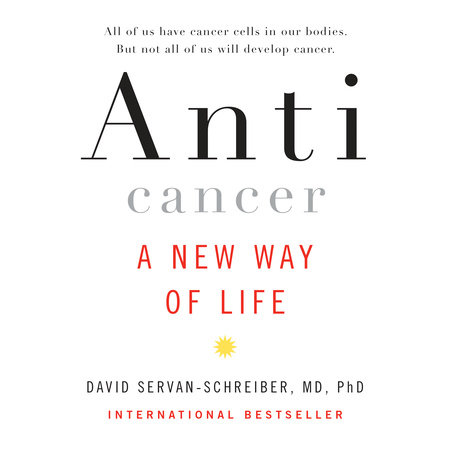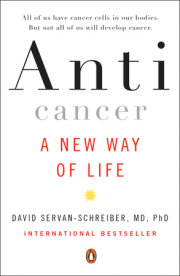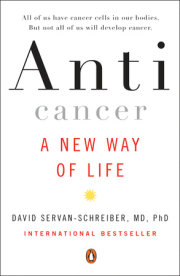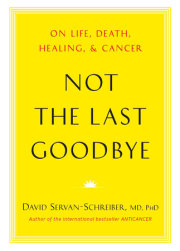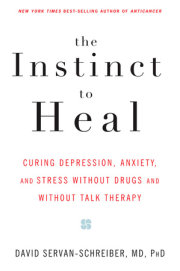Foods That Act Like Medications
From ANTICANCER: A New Way of Life by David Servan-Schreiber, MD, PhD
Foods That Act Like Medications
If certain foods in our diet can act as fertilizers for tumors, others, to the contrary, harborprecious anticancer molecules. As recent discoveries show, these go far beyond the usual vitamins,minerals, and antioxidants.
In nature, when confronted with aggression, vegetables can neither fight nor flee. To survive,they must be armed with powerful molecules capable of defending them against bacteria,insects, and bad weather. These molecules are phytochemical compounds with antimicrobial,antifungal, and insecticide properties that act on the biological mechanisms of potentialaggressors. They also have antioxidant properties that protect the plant’s cells from dampnessand the sun’s rays (by preventing cellular “rust” from forming when the cell’s fragile mechanismsare exposed to the corrosive effects of oxygen).
Plums, Peaches, and Nectarines: It’s Time for Stone Fruit
Berries have recently found some competition: peaches, plums, nectarines, etc. (collectivelyknown as stone fruit), whose anticancer virtues were previously unknown. According to agroup of researchers in Texas who reviewed more than a hundred species, these fruits—particularlyplums—are at least as rich in anticancer elements as small berries. In this time ofeconomic recession, it’s good to know that a single plum contains as many antioxidants as ahandful of berries and costs far less. In laboratory tests, stone fruits have also demonstratedtheir efficacy against breast cancer cells and cholesterol.
Probiotics
The intestines ordinarily contain “friendly” bacteria, which help digestion and facilitate regularbowel movements. They also play an important stabilizing role for the immune system.Among the most common of these bacteria are Lactobacillus acidophilus and Lactobacillusbifidus.
It has been demonstrated that these probiotics inhibit the growth of colon cancer cells.Their effect on the facilitation of bowel movements also lowers the risk of colon cancer by reducingthe time the intestines are exposed to carcinogenic substances in food. Probiotics thusalso play a role in detoxification. In addition, according to a 2006 Korean study, probiotics improvethe performance of the immune system, as well as increasing the number of NK cells.Organic yogurts and kefir are good sources of probiotics. Soy yogurts are usually enrichedwith probiotics. These precious bacteria are also found in sauerkraut and kimchi.Finally, certain foods are prebiotics, which means they contain polymers of fructose, whichstimulate the growth of probiotic bacteria. Examples are garlic, onions, tomatoes, asparagus,bananas, and wheat.
Green Tea
Rich in polyphenols, including catechins (and particularly epigallocatechin gallate-3, orEGCG), which reduce the growth of the new vessels needed for tumor growth and metastases.It is also a powerful antioxidant and detoxifier (activating enzymes in the liver that eliminatetoxins from the body), and it facilitates the death of cancer cells by apoptosis. In the laboratory,it enhances the effects of radiotherapy on cancer cells.
Turmeric and Curry
Turmeric (the yellow powder that is one of the components of yellow curry) is the most powerfulnatural antiinflammatory identified today. It also helps stimulate apoptosis in cancercells and inhibit angiogenesis. In the laboratory, it enhances the effectiveness of chemotherapyand reduces tumor growth.
Take note: To be assimilated by the body, turmeric must be mixed with black pepper(not simply with peppers). Ideally, it must also be dissolved in oil (olive, canola, or linseed oil,preferably). In store-bought curry mixes, turmeric represents only 20 percent of the total. Soit’s better to obtain turmeric powder directly.
Recommendations for use: Mix ¼ teaspoon of turmeric powder with ½ tablespoon ofolive oil and a generous pinch of black pepper. Add to vegetables, soups, and salad dressings.A few drops of agave nectar can remove the slightly bitter taste.
Ginger
Ginger root also acts as a powerful antiinflammatory and an antioxidant (more effectivethan vitamin E, for example) and has protective effects. It acts against certain cancer cells.Moreover, it helps reduce the creation of new blood vessels. A ginger infusion tea also helpsalleviate nausea from chemotherapy or radiotherapy.
Recommendations for use: Add grated ginger to a vegetable mix while it is cooking in awok or frying pan. Or marinate fruits in lime juice and grated ginger (a touch of agave nectarmay be added for those who prefer more sweetness). Make an infusion by cutting a smallpiece of ginger (about an inch) into slices and steeping in boiling water for ten to fifteenminutes. Can be drunk hot or cold.
Cruciform Vegetables
Cabbages (brussels sprouts, bok choy, Chinese cabbage, broccoli, cauliflower, etc.) containsulforaphane and indole-3-carbinols (I3Cs), which are powerful anticancer molecules. Sulforaphaneand I3Cs are capable of detoxifying certain carcinogenic substances. They preventprecancerous cells from developing into malignant tumors. They also promote the suicideof cancer cells and block angiogenesis. In 2009, at the Cancer Research Center of the Universityof Pittsburgh, biologist Dr. Shivendra Singh and his team studied the impact of sulforaphane—an antioxidant contained in cruciform vegetables—on prostate cancer in mice.
They made two radical new discoveries. First, consumption of sulforaphane three times aweek considerably increases the action of NK cells against tumors (by more than 50 percent).Second, tumor-carrying rats that consumed sulforaphane were shown to have half as muchrisk of developing metastases as those that did not.
Take note: Avoid boiling cabbage and broccoli. Boiling risks destroying sulforaphaneand I3Cs.
Recommendations for use: Cover and steam briefly or stir-fry rapidly in a wok with alittle olive oil.
Copyright © 2009 by David Servan-Schreiber MD, PhD. All rights reserved. No part of this excerpt may be reproduced or reprinted without permission in writing from the publisher.

